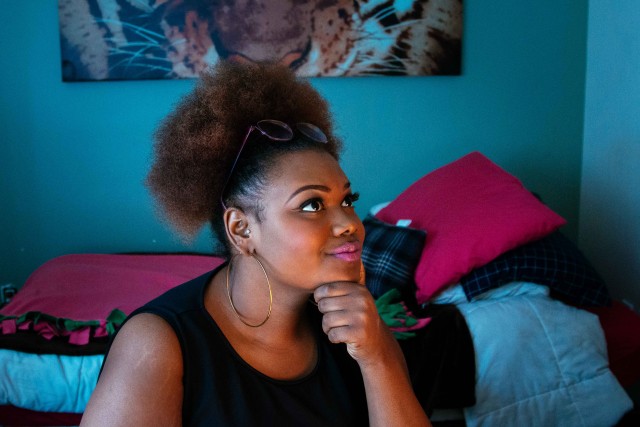
The diabetes epidemic is not abstract to Erica Sheppard McMath. As a girl, she watched her uncle deteriorate each time she saw him at family events. His eyes yellowed before he went blind. Then, his foot was amputated. Finally, he died from diabetes-related complications.
“It’s like seeing someone literally fall apart limb by limb because of what they’re putting in their mouth,” said McMath.
Growing up, diabetes was everywhere. In just a few years, one aunt was blind at 32, another was on dialysis, and a 9-year-old cousin started insulin treatment.
Her own health suffered as her home life descended into chaos. A fight with her mother’s boyfriend, who was an alcoholic, landed her in foster care at age 15.
“I was dealing with the pain of living in a group home, with the pain of sexual abuse,” she says. “I dealt with my pain through food because that was the only thing that could calm me down.”
She gained a lot of weight, increasing her risk for developing diabetes. She knew that her source of comfort was the same thing that was killing her family members.
That tension became the subject of her slam poem “Death Recipe,” which she performed on HBO’s Brave New Voices in 2010.
In it, she criticizes herself, her community, and above all, the unequal society McMath says contributed to her family’s health crises. The poem begins, “We eat like we still slaves/ cause back in the days we got what whites didn’t want.”
She says that “things like chitlins or pig’s feet — in slavery times you ate whatever was available to you.”
McMath sees a connection to today. “If you don’t have enough money to consider other options, your focus is just staying alive. It is a poor man’s appetite, and it’s absolutely killing us.”
Prescription for Diabetes: A History Lesson
“You cannot find a McDonald’s in San Francisco, except for in communities of color,” says Zea Malawa, a pediatrician in San Francisco’s Bayview neighborhood, where life expectancy is 14 years less than in a nearby affluent neighborhood.
She says fast food and sodas “are like the modern iteration of pig’s feet — the garbage falling down on disenfranchised communities.”
This perspective, says Malawa, is an important part of her medical practice.
“One thing I often talk about with families around cooking is (that) this food comes from a time when we spent 10-hour days in the field in the South,” she says. “That makes sense when you’re burning incredible calories, but now, we’re sedentary.”
Malawa says she re-frames nutrition advice this way because too often in the doctor’s office, “people feel patronized, like our culture is negated or wrong — like you’re saying their grandmother did it all wrong.”
Grandmothers weren’t all wrong for expressing their culture and their love through food, says Malawa, even though an excess of those foods can contribute to obesity and diabetes.
Instead, she says, “it’s important to ask, how is structural racism playing into this? How is this is an all-of-us problem?”
Malawa says this conversation helps parents feel empowered instead of marginalized, which opens the door to healthier eating for both parents and kids.
Food Industry To Blame
McMath says that her uncle who ultimately died of diabetes complications did drink soda, but adds that, “a factory made that soda and sold it at a very affordable price.”
UCSF endocrinologist Robert Lustig puts it in more stark terms. He compares the added sugar in processed foods to alcohol and tobacco — an addictive, disease-causing substance that needs to be regulated. “The food industry cannot be given carte blanche. They’re allowed to make money, but they’re not allowed to make money by making people sick,” Lustig told The Guardian.
Advocates say food and soda companies aggressively market sugary drinks and unhealthy food to children of color. For example, black children and teens saw more than twice as many ads for sugary drinks and energy drinks on TV compared with white children and teens in 2013, according to Yale’s Rudd Center for Food Policy and Obesity.
“I call it food addiction,” said McMath, “it’s an everyday struggle.”
Obligated to Do Something
McMath handles stress differently now and eats more fresh food. She’s lost 85 pounds. She’s a sociology major, and will graduate from San Francisco State University in a few months.
Her life is a lot better than when she wrote the poem, but she’s dismayed to see her family’s health problems reflected in the elementary school students she works with.
“I was eating a regular salad with tomatoes and onions, and a 7-year-old boy asked me, ‘What’s that?’ Students who have never seen an eggplant or fresh tomato turn into adults who barely know what those vegetables look like,” she says.
She wants to turn that frustration into action now that she’s graduating. She says that her “goal is to focus on food and justice, to bridge this gap between the wealthy and the unwealthy.”
“We’re living in this epidemic of death,” she says. “Death from food, homicide, mental death, incarceration. My people are passing away at numbers that are crazy, and I feel obligated to do something about it.”
Watch McMath perform her poem “Death Recipe” in this video: